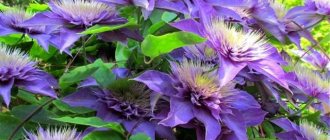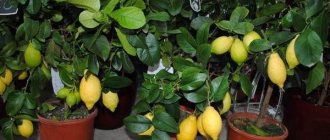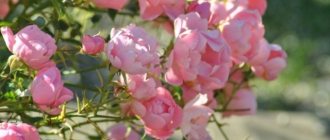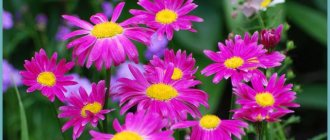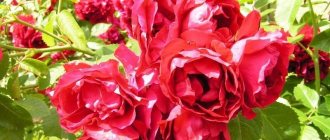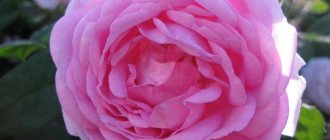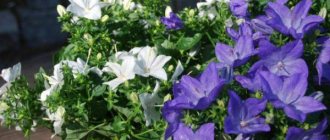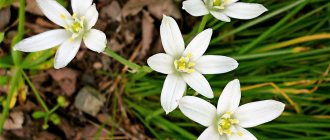It is important to know that some flowers that look like roses, but are not roses, pose a danger that can be blocked with the right fertilizers and other manipulations.
Terry primroses
As for the external data, what immediately catches your eye is not only the resemblance to a rose, but also its special beauty, the flower seems to be painted in watercolor, this attracts more attention than a classic rose. Primroses are bushes that bear small flowers up to 5 cm in size, depending on the variety. The palette of shades is also quite large: pink, burgundy, raspberry, and yellow. As for the exactingness, everything here is 5/5, because you don’t even have to tinker with the soil for long - any will do. Open area or potty, it doesn’t matter.
There is a way to increase flowering. To do this, primroses are planted in loose soil, previously saturated with chemical elements, the place should not be sunny, and watering should be frequent, then they will delight you with beautiful flowering for up to 4 months.
Nothing is perfect, so there is one thing - the process of formation and flowering is quite slow, the first bright buds will begin to appear only after a year, and this is with proper care.
Asian buttercup or ranunculus
This is a beautiful Turkish flower, which is completely unsuitable for the Russian cold, so it is better to immediately remove the option of planting it in the garden. There are no special care recommendations. The height of a fully ripe flower is up to 30 centimeters, several buds are formed on it, their shades are quite varied: yellow, red, pink, white. They look very interesting, because the size of the buds is quite large for this height - 5-7 cm. In some ways, ranunculus resembles both a rose and a peony, such a unique hybrid. What care features will have to be observed for high-quality cultivation:
- the tubers look like “crow’s feet”, as for their number, at least four “claws”, this is for normal cultivation in small quantities;
- before planting the first tuber, you need to keep it in a warm cloth and put it in a warm place;
- if you plan to plant in open ground, it should be done around May so that flower formation begins by summer;
- feeding is required, but once every two weeks, not more often. A good fertilizer requires a small amount of nitrogen, and after the seedlings have formed, the fertilizer should also contain phosphorus and potassium.
What types of roses are there - an overview of groups, types and varieties
Before you can distinguish a real rose from flowers similar to it, you need to understand what types of roses there are. There are 9 main groups.
Park roses
This group includes ancient roses, including decorative rose hips. As the name implies, such plants are often used for landscaping parks and gardens; they look great both in single and group plantings. Park roses are winter-hardy, rarely get sick and are not very picky about caring for them. They often decorate flower beds on city streets.
These roses bloom early and abundantly, but they bloom for a short time and only once per season. However, the rich aroma exuded by these flowers is truly intoxicating.
In decorative varieties of park roses, the flowers reach 10 cm in diameter, they are single or collected in inflorescences of 3-6 pieces. The leaves are large, leathery, wrinkled. The height of a wide and dense bush is usually 1-2 m.
This group includes wrinkled rose (rugosa).
Varieties and hybrids: Grotendorst, Pink Grotendorst, Ritausma.
Repair roses
The main feature of these roses is repeated flowering. On vigorous (up to 2 m in height), erect and spreading bushes, large, fragrant, double flowers with a diameter of 8 to 16 cm bloom in the second half of June. Most often they are red, pink, beige, white or yellow. In July-August, remontant roses bloom again, although not so abundantly.
These roses are winter-hardy, but in severe winters they can still freeze, so they require shelter. In addition, they are susceptible to fungal diseases.
Varieties and hybrids: Georg Arends, Georg Dixon, Paul Neuron, Frau Karl Druschki, Hugh Dixon.
Hybrid tea roses
These popular roses are descended from heat-loving Chinese tea roses crossed with remontant roses. Thanks to this, it was possible to obtain flowers whose characteristics were superior to all previously known species and varieties.
In central Russia, hybrid tea roses bloom in the second half of June and until the frosts continue to delight with their lush, double flowers of various colors, which are located singly on the stem or collected in small inflorescences. The height of the bush is from 60 to 150 cm.
Hybrid tea roses are heat-loving and picky about where they grow. They are often affected by diseases and attacked by pests. However, with proper care and good winter cover, they bloom profusely all summer.
Varieties and hybrids: Angelique, Athena, Black Baccarat, Gloria Dei, Duftvolke, Mainzer Fastnacht, Nostalgie, Limbo, Sonia.
Sometimes the group Grandiflora (large-flowered roses) is distinguished separately. As a rule, it includes hybrid tea roses. The most popular variety is Queen Elizabeth.
Polyantha roses
On low, dense and heavily branched bushes in mid-July, many small roses (up to 6 cm in diameter) bloom, collected in inflorescences of 20-100 flowers. They can be either simple or terry.
Polyantha roses bloom until late autumn; their cut flowers can last up to 15 days. The color can be white, pink, red, orange. Polyanthus roses are also distinguished by the fact that they have almost no thorns.
In the middle zone, the bushes of these roses require light shelter. They can also be grown in the Urals and Siberia.
Polyantha roses are most often used in group plantings and borders, and some short varieties (for example, Mutertag and Dick Koster) are suitable for growing in containers.
Varieties and hybrids: Border King, Gloria Mundi, Yvonne Rabier, Cameo, Orange Triumph.
Floribunda roses
These profusely blooming roses are the result of crossing dwarf polyantha roses with hybrid tea roses. Their flowering is not only abundant, but also long-lasting (from July to late autumn), continuous. Flowers can be either simple or double. They are quite large (the shape and size are similar to hybrid tea roses) and are collected in inflorescences. The height of the bush can vary from 30 to 100 cm.
Floribunda roses are characterized by increased winter hardiness and disease resistance.
Varieties and hybrids: Iceberg, Galaxy, Diadem, Georgette, Zorina, Carte Blanche, Lily Marlene, Nicolo Paganini, Nicole, Sangria, Frisia, Shocking Blue.
In the floribunda group, there are low-growing roses called patio (also known as mini-floribunda, or mini-flora). They do not exceed 50 cm in height and are most often grown in containers or in the foreground of borders.
Miniature roses
This is a small copy of garden roses. Densely leafy bushes up to 40 cm high with small double flowers of a wide variety of colors (from greenish to purple) are often grown indoors. Here roses can bloom almost continuously all year round. And in open ground, miniature roses bloom from May to late autumn and require light shelter for the winter.
Miniature roses look great in rocky hills, rock gardens and borders, and they are also used to create boutonnieres to decorate hairstyles or festive outfits.
Varieties and hybrids: Baby Masquerade, Denise Cassegrain, Hummingbird, Mandarin, Stars and Stripes, Zwergkening.
This is interesting: How to properly collect sea buckthorn: popular methods and convenient devices
Ground cover roses
This group includes creeping shrubs with densely leafy long shoots (up to 4 m) that densely cover the soil. Flowers can be simple, double or semi-double, small or medium. Most groundcover varieties are characterized by long and abundant flowering. Such plants do not require special care and are resistant to fungal diseases.
Ground cover roses are used for landscaping slopes and creating standard weeping roses.
Varieties and hybrids: Alba Meian, Basi, Gold Carpet, Ondela, Snow Ballet, Suney, Fairy.
climbing roses
These roses have small flowers (2-5 cm in diameter), collected in large inflorescences, and long, creeping shoots (lashes) that require support. Therefore, climbing roses are usually used for vertical gardening: they decorate pergolas and arches.
Climbing roses are usually divided into 2 groups:
- Small-flowered (ramblers) - with shoots up to 5 m long, small, odorless flowers that bloom once.
- Large-flowered (climbers) - with larger flowers, shaped like hybrid tea roses. They may bloom again during the summer.
Varieties and hybrids: Dorothy Perkins, New Dawn, Rosarium Uetersen, Flamentanz, Schwanensee, Excelsa.
semi-climbing roses were classified as a separate group - intermediate between climbers and hybrid tea or floribunda roses. Nowadays they are most often classified as shrubs (shrubs).
Shrub roses (scrubs)
This group unites powerful rose bushes, which are distinguished by their tall growth, abundant and long-lasting, but single flowering, and good resistance to unfavorable growing conditions. This group also includes large wild rose bushes and Austin English roses - with densely double flowers that exude a rich aroma.
Varieties and hybrids : Abraham Darby, Graham Thomas, Mishka, Rhapsody in Blue, Rococo, Charles Austin, Hansa Park, Chippendale, Charlotte.
Begonia
Another flower is ready to compete with the rose. This is a begonia, familiar to everyone since childhood - a pet, which received its name from the name of Begon - the governor of Brazil.
Presented in two groups, consisting of beautifully flowering and decorative deciduous varieties, these plants are distinguished by their unpretentiousness and generous flowering. Coming to window sills and greenhouses from the mountain and tropical forests of equatorial Africa and South America, begonia has more than 900 species and varieties. The plant surprises with its size, which can be miniature or gigantic, supporting the ceiling of the apartment. The stem resembles bamboo. The inflorescences of the flower resemble a rose or dahlia, and the various shades delight the owners of this plant. Begonia requires simple care: it easily tolerates shade and partial shade, loves moist soil, but does not tolerate stagnant water, so good drainage is needed. If the leaves are fleecy, then spraying should be moderate. A plant planted in a flowerbed or in a flowerpot with peat soil will thank the gardener with luxurious flowering.
Chinese rose or hibiscus
Hibiscus are flowers similar to Eustoma roses.
People most often call this flower “Chinese rose”. In appearance, the plant is very similar to an ordinary rose. At the same time, a very large number of varieties can be planted both in open ground and used for home cultivation. Abundant flowering will not begin immediately, but only after a couple of years, when the root becomes stronger. Hibiscus will delight you with its bright buds from about June to October. It blooms in a variety of colors and shades depending on the variety: burgundy, red and pinkish - in general, another similarity with an ordinary rose. The hibiscus hybrid is very interesting; it was created by crossing three different varieties, but its appearance is even more interesting - about 50 large buds can appear on one branch, then they bloom within 24 hours, after which they disappear on their own. But the flowering will not end there; the next day you will notice new small buds.
We must not forget about fertilizers, a flower with such a life cycle cannot be depleted, there must be constantly nourished soil, but without chemicals, ordinary nitrogen or phosphorus additives will be enough. All manipulations need to be performed about twice a month.
Hellebore
Hellebore is a perennial frost-resistant flower. It is called the Christmas Rose. The flowering period occurs in winter or early spring. The leaves have a bright green color. They do not lose their decorative properties throughout the year.
The diameter of the flower can reach about 13 cm. Color: yellow, cream, white and different shades of pink. The genus of hellebores includes about 20 species.
It is recommended to plant such flowers next to bushes, fences and walls of the house. They do not need frequent transplants, since the growth process is very slow.
Hellebores pair well with daffodils, primrose, hyacinth and crocuses. In cold regions, the flower is grown as an indoor flower.



